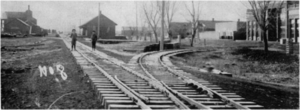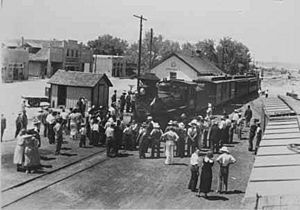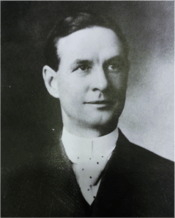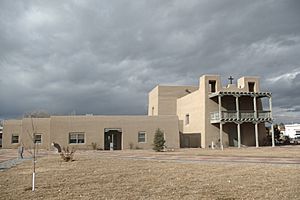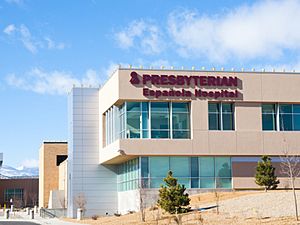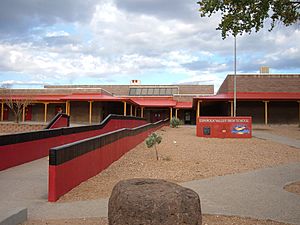Española, New Mexico facts for kids
Quick facts for kids
Española
|
||
|---|---|---|
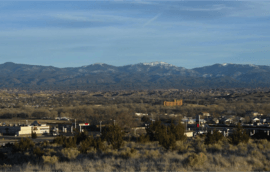
Skyline view from the city's Industrial Park
|
||
|
||
| Etymology: Founded as San Juan de los Caballeros, as capital of Nuevo México for Española (Spanish) | ||
| Nickname(s):
"The Low Rider Capital of The World", Spaña, Espa
|
||
| Motto(s):
The heart of northern New Mexico…where cultures unite.
|
||
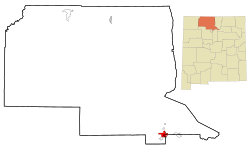
Location of Española, New Mexico
|
||
| Country | United States | |
| State | New Mexico | |
| County | Rio Arriba, Santa Fe | |
| Founded | 1598 | |
| Incorporated | 1925 | |
| Named for | See history section | |
| Government | ||
| • Type | Mayor-council government | |
| Area | ||
| • Total | 8.34 sq mi (21.61 km2) | |
| • Land | 8.22 sq mi (21.30 km2) | |
| • Water | 0.12 sq mi (0.31 km2) | |
| Population
(2010)
|
||
| • Total | 10,495 | |
| • Estimate
(2019)
|
10,044 | |
| • Density | 1,221.60/sq mi (471.64/km2) | |
| ZIP codes |
87532, 87533
|
|
| Area code(s) | 505 | |
| FIPS code | 35-25170 | |
| GNIS feature ID | 928729 | |
Española is a city primarily in Rio Arriba County, New Mexico, United States. A portion of the central and eastern section of the city is in Santa Fe County. Founded as a railroad village some distance from the old Indian town of San Juan de los Caballeros (now renamed Ohkay Owingeh),, it was named Española and officially incorporated in 1925. It has been called the first capital city in the United States. At the 2010 census, the city had a total population of 10,495. Española is within the Albuquerque–Santa Fe–Las Vegas combined statistical area.
Contents
History
Etymology
Española was referred to as La Vega de los Vigiles (Vigil's Meadow) before the presence of railroads. It is believed that the town that began as Española was named by railroad workers. At the time of railroad construction, a small restaurant in the area was nicknamed "La Española". This was because of the large presence of Spanish women in the area. The name became official by 1900 and Española became a small railroad town. Before the railroads, this is where Spanish and Native American people had settled for hundreds of years, making a living from farming along the Rio Grande.
Early settlers
The Española area (known as the "San Juan Valley" to the early Spaniards) is also known as the first European-founded capital of the "New World." The region was explored In 1598 by Don Juan de Oñate. He declared the area a capital for Spain, the area of Don Diego de Vargas' new villa at Santa Cruz. Oñate arrived in the Española area on July 11, 1598, at the confluence of the Chama River and the Rio Grande, where he established a camp at a place then called Yunque-Yunque. He created a Spanish settlement in an area already inhabited by the indigenous descendants of the Anasazi.
Railroad Era
Prior to the arrival of the narrow gauge Denver and Rio Grande Western Railroad (Chili Line) in 1880, the hamlet on the west-side of the Rio Grande was known as La Vega de los Vigiles in reference to the Vigil family who initially settled that area. The earliest document found indicates that La Vegas de los Vigiles had been populated by 1751, over 100 years before the Chili Line's arrival. With the coming of the railroad the name of the hamlet was changed to Española. The Chili Line ran predominantly through the Rocky Mountain region announced a route extension of its narrow gauge into northern New Mexico. The line was built along the Rio Grande, and later was known as the Chili Line. The route would extend into what today is the downtown Española area, and the railroad began selling lots in the area. Anglo merchants, mountain men, and settlers slowly filtered into Española. Frank Bond and his brother George, who were Canadian emigrants would later arrive in the city, together they established the state's largest mercantile and a multi–million dollar wool empire, with them came economic growth and prominence. Española was the headquarters for all the Bond family interests which included over 12 businesses across New Mexico.
Many residents of the nearby town of Santa Fe were not happy with the decision and failure of connection of the railroad, prompting protest. The Española station however, included an engine facility station along with a roundhouse and turntable so it could service the locomotives. The facilities were built but torn down or no longer in use after six years; plans for the town had changed. The railroad would later reach Santa Fe to connect with the Atchison, Topeka and Santa Fe Railway in late 1887.
Frank R. Frankenburger, a business man born in Fort Scott, Kansas, was the first "elected" mayor; he was elected in 1923. The first mayor who was chosen in "popularity" was Frank Bond, in 1907. In 1925 Española was incorporated as a city. As the population rose, there was a high demand for public education in the city. Española High School was established; it would be the largest school in the area for decades. The first high school in the area, however, was Santa Cruz High School. Two miles away from downtown Española, it opened in 1906 in the historic Santa Cruz area. Both high schools are no longer in existence after a merger of school districts in 1975.
The existence of the railroad began to dissipate as minimal passenger traffic and low shipments forced the railroad to close in the early 1940s. Many locals would become unemployed and would follow the railroad to Santa Fe, Albuquerque and central Colorado for jobs. Española's population would fall dramatically and many homes in the downtown became abandoned. Most of the locals who remained would turn to farming as a way of life. Many people saw Española as another failed railroad town. The city removed the railroad tracks and the train depot in the 1960s, and the railroads completely vanished.
Businesses in Española vigorously opposed the abandonment of the Denver & Rio Grande Western Railroad's narrow gauge during the early 1940s. Their calls for continued rail service were at odds with the grim realities of the marketplace, which had for years rendered the "Chili Line" woefully unprofitable. Although Española was an integral part of the saga of railroad construction in the West, it was destined to become one of the region's first notable communities bereft of its trains.
American communities in the age of the rail line abandonment
Post-railroad
In the 1980s, many historical buildings and homes of historical significance were torn down for urban renewal. Española followed many other New Mexico cities in this trend, but in Española, it failed. More modern business began to move into town, but the growth of Española had now expanded east across the Rio Grande. Although several buildings of historical significance remain in downtown Española, many are unused or abandoned. Strip malls became visible in Española, the first being the 'Big Rock shopping center', founded by oil tycoon Roy Honstein. With the beginnings of Manhattan Project in nearby Los Alamos, many locals would find jobs at the Los Alamos National Laboratory, which would later employ nearly 9% of Española's population.
In the 1990s, a controversial plan to build a "plaza" and mission church where many historic buildings once stood was up for consideration. The city agreed to the plan, and locals supported the plaza. Although a plaza never existed in Española before the railroads, it was built to pay tribute to the Spanish culture in the area.
Recent history
In 1998, Española celebrated the 400th anniversary of the colonization by the Spanish and the founding of the first permanent European colony in North America. The event was celebratory for some and controversial for others.
On September 18, 2008 then Sen. Barack Obama, the Democratic nominee for President of the United States, visited Española for a rally at the city's New Plaza in the Main Street district.
Geography
Española is located at 36°0′7″N 106°3′53″W / 36.00194°N 106.06472°W (36.001884, -106.064587).
According to the United States Census Bureau, the city has a total area of 21.9 square kilometers (8.5 sq mi), with 21.7 square kilometers (8.4 sq mi) land and 0.2 square kilometers (0.077 sq mi) water, for a total of 0.83%.
Española lies at an elevation of around 5,595 feet (1,705 m) with much variance. It is in a valley nestled between the Jemez and Sangre de Cristo mountain ranges, and the meeting point of three rivers, the Rio Grande, the Rio Chama, and the Rio Santa Cruz.
Climate
July is the warmest month in Española, with an average high of 91 °F (33 °C). The highest recorded temperature was 107 °F (42 °C) in 2003. The average coolest month is January at 45 °F (7 °C). The lowest recorded temperature was −38 °F (−39 °C) in 1971. The maximum average precipitation occurs in August with an average of 1.90 inches (48 mm).
| Climate data for Española, New Mexico | |||||||||||||
|---|---|---|---|---|---|---|---|---|---|---|---|---|---|
| Month | Jan | Feb | Mar | Apr | May | Jun | Jul | Aug | Sep | Oct | Nov | Dec | Year |
| Record high °F (°C) | 67 (19) |
75 (24) |
84 (29) |
88 (31) |
98 (37) |
105 (41) |
107 (42) |
103 (39) |
99 (37) |
89 (32) |
84 (29) |
72 (22) |
107 (42) |
| Average high °F (°C) | 45 (7) |
52 (11) |
60 (16) |
69 (21) |
78 (26) |
88 (31) |
91 (33) |
87 (31) |
81 (27) |
72 (22) |
58 (14) |
47 (8) |
69 (21) |
| Average low °F (°C) | 14 (−10) |
20 (−7) |
26 (−3) |
33 (1) |
41 (5) |
50 (10) |
57 (14) |
55 (13) |
47 (8) |
34 (1) |
24 (−4) |
15 (−9) |
35 (2) |
| Record low °F (°C) | −38 (−39) |
−18 (−28) |
0 (−18) |
14 (−10) |
17 (−8) |
28 (−2) |
35 (2) |
37 (3) |
25 (−4) |
10 (−12) |
−21 (−29) |
−16 (−27) |
−38 (−39) |
| Average precipitation inches (mm) | 0.40 (10) |
0.40 (10) |
0.60 (15) |
0.60 (15) |
0.70 (18) |
0.70 (18) |
1.60 (41) |
1.90 (48) |
1.20 (30) |
0.90 (23) |
0.60 (15) |
0.50 (13) |
10.1 (256) |
| Source: weather.com | |||||||||||||
Air quality
According to an annual report by the American Lung Association, the Santa Fe-Espanola CSA (metropolitan area) has the cleanest ozone layer in the country (ranked #1), cleanest area in the country for 24-hour particle pollution (ranked #1) and cleanest area in the country for annual particle pollution (ranked #2).
Demographics
| Historical population | |||
|---|---|---|---|
| Census | Pop. | %± | |
| 1890 | 398 | — | |
| 1900 | 1,405 | 253.0% | |
| 1910 | 1,802 | 28.3% | |
| 1920 | 2,412 | 33.9% | |
| 1930 | 4,269 | 77.0% | |
| 1940 | 2,984 | −30.1% | |
| 1950 | 2,489 | −16.6% | |
| 1960 | 3,472 | 39.5% | |
| 1970 | 7,923 | 128.2% | |
| 1980 | 8,127 | 2.6% | |
| 1990 | 8,828 | 8.6% | |
| 2000 | 9,504 | 7.7% | |
| 2010 | 10,495 | 10.4% | |
| 2015 (est.) | 10,066 | −4.1% | |
|
|
|||
2000 census
At the census of 2000, there were 9,688 people, 5,751 households, and 4,569 families residing in the city. The population density was 1,155.4 people per square mile (446.4/km²). There were 5,107 housing units at an average density of 189.2/square kilometer (489.8/square mile). The racial makeup of the city was 67.55% White, 0.58% African American, 2.86% Native American, 0.14% Asian, 0.06% Pacific Islander, 25.56% from other races, and 3.25% from two or more races. 84.38% of the population were Hispanic or Latino of any race.
There were 5,751 households, of which 35.6% had children under the age of eighteen living with them, 42.5% were married couples living together, 18.5% had a female householder with no husband present, and 31.5% were non-families. 26.2% of all households were made up of single individuals, and 9.7% had someone living alone who was sixty-five years of age or older. The average household size was 2.56 and the average family size was 3.08.
In the city, the population was spread out, with 27.8% under the age of 18, 9.7% from 18 to 24, 28.1% from 25 to 44, 22.1% from 45 to 64, and 12.3% who were 65 years of age or older. The median age was thirty-four years. For every 100 females there were 95.3 males. For every 100 females aged eighteen and over, there were 94.6 males.
The median income for a household in the city was $27,144, and the median income for a family was $32,255. Males had a median income of $25,558 versus $23,177 for females. The per capita income for the city was $14,303. 21.6% of the population and 16.5% of families were below the poverty line. Out of the total population, 28.4% of those under the age of eighteen and 15.1% of those sixty-five and older were living below the poverty line.
2010 census
As of the census of 2010, there were 10,224 residing in the city.
The racial makeup of the city was:
- 8.8% White (alone)
- 0.3% Black or African American
- 2.3% Native American
- 1.0% Asian
- 0.1% from other races
- 0.4% Multiracial (two or more races)
- 87.1% of the population were Hispanics or Latinos (of any race)
Arts and culture
Immigrant culture
There has been a steady influx of undocumented immigration to the Valley for the last decade, which has significantly increased their visibility and influence in the area. Española (especially the neighboring community of Sombrillo) is also home to the largest community of ethnically diverse Sikhs in the world. While most Sikhs descend from the Punjab region of India, the Sikhs in Española come from all over the world.
Plaza De Española
The fountain at Plaza de Espanola was designed as a replica of the Alhambra. The plaza is home to the Convent Mission, administered by the Episcopal Church.
Telecommunications
Satview Broadband, headquartered in Reno, is the local cable television company and is served by Winstream Communications for telecom and broadband service.
Festivals and Activities
Española's restaurants and convenience stores are popular with travelers between Santa Fe and northern communities, as well as with local people. The local fiestas are held in the summer and to commemorate the cultural diversity of the city.The fiestas include live New Mexico and/or country music, vendors and parades.
There are many locations near Española that provide for outdoor activity such as hiking, biking, and river sports like rafting and kayaking. Nearby winter sports include skiing (downhill and cross-country) and snowboarding.
Parks and recreation
Recreational facilities
- Penny Roybal Garcia (Ranchitos) Aquatic Center
- Richard L. Lucero Recreation Center
Major community parks
- Plaza de Española Park
- Vietnam Veteran's Memorial Park
- Ranchitos Park
- Valdez Park (dedicated in memory of Española native Phil Valdez)
Golf courses
- Black Mesa Golf course
Economy
| Largest Employers in Española | |
|---|---|
| 1 | Los Alamos National Laboratory |
| 2 | Española Public Schools |
| 3 | Presbyterian Healthcare Services |
| 4 | Akal Security |
| 5 | Northern New Mexico College |
| 6 | Northern Pueblos Gaming Council |
| 7 | Walmart |
| 8 | Lowe's |
| 9 | City of Española |
| 10 | Rio Arriba County |
The Los Alamos National Laboratory is the largest employer in Española; it accounts for over 12% employment of residents. The education sector is the second largest employer, the Española Public Schools is the 16th largest school district in New Mexico. Recently, Northern New Mexico College has expanded its degree programs and made massive improvements to its campus, adding a new library and a new School of Education. Larger local businesses include Akal Securities Inc, a security company that employees over 500 people.
Española has seen much commercial development on Riverside Drive, the city's secondary main road. Retail and eatery chains such as Lowe's, Chili's and GameStop are anchors of a massive shopping square located next to Wal-Mart which came into the city in 1999. CVS/Pharmacy and Petsense also added locations in Española.
Education
Public schools
The City of Española is a part of the Española Public Schools district, with six of its 14 schools being located within the city.
- Española Valley High School
- Carlos F. Vigil Middle School
- Elementary schools
- Eutimio Tim Salazar III "Fairview" Elementary
- James H. Rodriguez "Española" Elementary
- Tony E. Quintana "Sombrillo" Elementary
- Kindergartens
- Los Niños Kindergarten Center
Charter schools
- McCurdy Charter School K-12
- La Tierra Montesori School of the Arts and Sciences
- Carinos de los Ninos Charter School
Private schools
- Holy Cross Catholic School (Roman Catholic Archdiocese of Santa Fe)
- Victory Faith Christian Academy
College
- Northern New Mexico College
Library
Española Public Library is located inside the Richard Lucero Center at 313 North Paseo De Oñate. Its collection is about 50,000 items.
Notable people
- Jack Aeby, environmental physicist
- Eppie Archuleta, weaver and textile artist
- Frank Bond, Canadian businessman
- Jacobo de la Serna, ceramic artist
- Sandra Dodd, unschooling advocate
- Kenneth John Gonzales, attorney and judge
- Robert B. Hall, geographer
- Leo Jaramillo, member-elect of the New Mexico Senate
- Joseph Maestas, member-elect of the New Mexico Public Regulation Commission
- Hari Jiwan Singh Khalsa, Sikh leader
- Patricia D. Lopez, computer scientist
- Richard Lucero, longest-serving mayor of Española
- Roger Montoya, humanitarian, artist, former gymnast, and politician
- Members of The Movin' Morfomen
- Nora Naranjo Morse, artist and poet
- Satya Rhodes-Conway, politician in Madison, Wisconsin
- Raemer Schreiber, physicist
- Harbhajan Singh Khalsa, founder of the 3HO movement, moved to Española
- Debbie Rodella, New Mexico state legislator, was born in Española.
- Scott Tipton, Member of the U.S. House of Representatives from Colorado's 3rd district, was born in Española.
See also
 In Spanish: Española (Nuevo México) para niños
In Spanish: Española (Nuevo México) para niños




